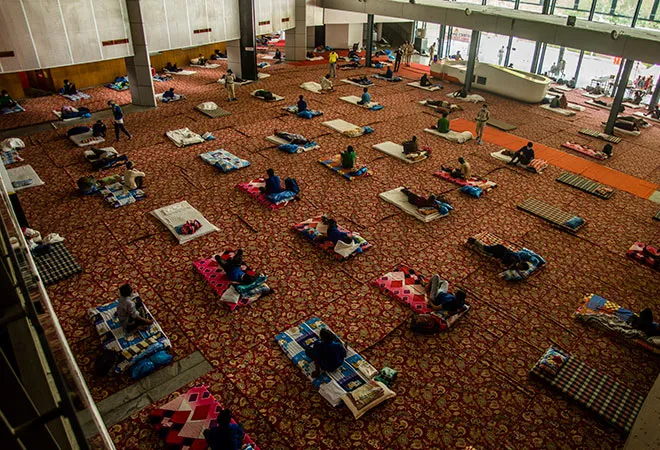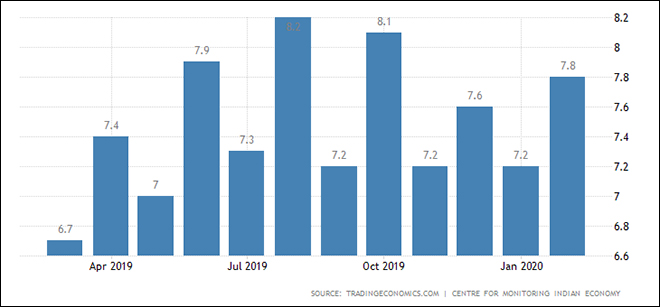
The spread of the coronavirus has spelt disaster for the world. It has caught the world ill-prepared to deal with a pandemic of such magnitude. It has confined people to their homes. Most importantly, it has robbed people of their jobs. Mass unemployment is a reality not just of India, but of the world as a whole. Yet, it is of greater adverse consequences for nations like India where, according to the Economic Survey 2018-19, 93 percent of the workforce operates in the informal economy. Given the inadequacy of social security, and irregular and uncertain income, it is highly unlikely that these individuals have any buffer resources to stock up and provide for themselves for unforeseen and drastic contingencies like the COVID-19.
The plight of daily wage workers, casual labourers and own account workers cannot even be imagined. Lack of food and shelter has already compelled a mass exodus of migrants at various locations back to their hometowns. Even those working for the organised private sector have lost or are on the verge of losing their jobs. The Centre for Monitoring Indian Economy (CMIE) informs that the unemployment rate in India might have just shot up to
23.4 percent for the week ended 5 April 2020. As far as March is concerned, the unemployment rate rose to 8.7 percent from 7.8 percent in February. As it appears, this time, poverty is not going to discriminate between the vulnerable and the well-off, grabbing several of the latter into its fold as well.
The cycle of unemployment has only begun, now that the nationwide lockdown had been further extended up to 3 May 2020. This extension, despite the partial relaxation in green and orange zones, will further deteriorate the employment scenario in the country. As of now, the lockdown does not hold for those operating in the essential services. Unemployment is unlikely to hit this sector as badly as it has hit its non-essentials counterpart. As everyone is anxious for the future and in consequence stocking up for the same, this essential services sector will see a heavy spike in demand. This will put an upward pressure on prices. But the lockdown will not allow the sector to respond with an increase in production. As such, the higher prices will further crowd out consumption pushing many into the gulf of starvation. If things do not de-escalate, then aggregate demand for essentials will begin to fall and then the essentials sector will also be hit by unemployment, further worsening the situation. How will India cope with the deepening unemployment crisis? This is even more worrisome given India’s track record in solving its unemployment conundrum.
Since the opening of the economy, India has shown a notorious tendency for ‘jobless growth.’ According to the census 2011, during the decade 2001-11, the average growth rate of the economy was 7.7 per cent per annum, while being a meagre 1.8
percent for employment. In one of its recent endeavours, the World Bank only partially supports the ‘jobless growth’ thesis. After having appropriated data from
60 surveys and censuses since 2001 to decode India’s employment situation, it finds that for every one percent increase in growth in India, on average, about 540,000 jobs are created. Through this analysis, the World Bank reached the conclusion that Indian economic growth has generated jobs though inadequate in both quantity and quality.
In recent times, since the Goods and Services Tax (GST) debacle and the launch of the demonetisation campaign, the jobless growth thesis gained a lot of traction in public discourse in India. In fact, India registered an unemployment rate of
6.1 percent in the year 2017-18, at a then 45 year high. In rural areas, it was at 5.3 percent, while in urban areas, it stood at 7.8 percent. As can be seen in the figure below, in the year 2019, the unemployment trend has only worsened.
What are the causes of such unemployment rates? On the demand side, high
unemployment has been associated with a declining labour force in the agricultural sector, and higher skills and education. On the supply side, restrictive factor markets, especially the labour market, rigidities which make doing business difficult and infrastructural bottlenecks have impeded employment generation. Consider the case of labour laws.
India’s restrictive labour laws, about 200 of them, have prevented India from leveraging its cheap labour and compelled Indian producers to adopt fairly capital-intensive technology.
Unemployment rates for the period April 2019 to February 2020 in India
 Source: TradingEconomics.com/Centre for Monitoring the Indian Economy
Source: TradingEconomics.com/Centre for Monitoring the Indian Economy
As per the Industrial Disputes Act (IDA),
production units with 100 or more employees need approval of the government for laying off an employee; an approval seldom given. There are laws that require the employer to seek government approval for even shifting a worker from one task to another. The Law forbids the hire of contract labour for certain tasks. Since these laws hold above certain threshold employment levels, firms are incentivised to operate in the informal sector.
Even the Modi government’s
efforts to boost employment generation have seen limited impact with an inadequately financed MNREGA programme, a failed Skill Development mission and a flawed social security programme (Pradhan Mantri Shram Yogi Maandhan). Even the recently proposed labour law
reforms have met with scepticism and disappointment by the labour class.
Given the structural realities of India’s factor markets and government’s ineffective endeavours to fix the unemployment situation, the circumstances that the COVID-19 crisis has brought will beset a herculean task in front of policymakers. In the short-run, India has no choice but to adopt accommodative fiscal and monetary policy, despite the double-edged sword of burgeoning fiscal deficit and rising inflation looming over the government’s head. India has to embrace the Keynesian economic principles of ‘digging trenches and filling them up”, that is deficit financing (given the circumstances, this will involve printing more money). The government will have to identify sectors with the maximum forward and backward linkages in terms of generating employment for this purpose. The banking sector will have to provide easy credit, but more specifically to the MSME sector, which happens to be the second largest employer in the country after agriculture. The migrants may have very well lost the confidence to migrate back to the urban areas for the sake of employment after what transpired with them post the national lockdown. The government will have to re-inculcate this confidence through effective confidence building measures. If the government fails in this regard, we will see a lot of disguised unemployment in the agricultural sector and a lot of pressure on it by virtue of a large number of people relying on it for their livelihoods.
After the COVID-19 crisis, India has a lot to contemplate. It has allowed a lot of structural deficits to persist in its economic architecture, specifically restrictive factor markets, rigid labour laws, fractured infrastructural profile and unbalanced urbanisation. These represent the long-term milestones that India must seek to achieve to correct the anomalies in its employment landscape. It is hoped that India will not wait for another pandemic to strike before it gets its employment scenario in order.
The views expressed above belong to the author(s). ORF research and analyses now available on Telegram! Click here to access our curated content — blogs, longforms and interviews.



 The spread of the coronavirus has spelt disaster for the world. It has caught the world ill-prepared to deal with a pandemic of such magnitude. It has confined people to their homes. Most importantly, it has robbed people of their jobs. Mass unemployment is a reality not just of India, but of the world as a whole. Yet, it is of greater adverse consequences for nations like India where, according to the Economic Survey 2018-19, 93 percent of the workforce operates in the informal economy. Given the inadequacy of social security, and irregular and uncertain income, it is highly unlikely that these individuals have any buffer resources to stock up and provide for themselves for unforeseen and drastic contingencies like the COVID-19.
The plight of daily wage workers, casual labourers and own account workers cannot even be imagined. Lack of food and shelter has already compelled a mass exodus of migrants at various locations back to their hometowns. Even those working for the organised private sector have lost or are on the verge of losing their jobs. The Centre for Monitoring Indian Economy (CMIE) informs that the unemployment rate in India might have just shot up to
The spread of the coronavirus has spelt disaster for the world. It has caught the world ill-prepared to deal with a pandemic of such magnitude. It has confined people to their homes. Most importantly, it has robbed people of their jobs. Mass unemployment is a reality not just of India, but of the world as a whole. Yet, it is of greater adverse consequences for nations like India where, according to the Economic Survey 2018-19, 93 percent of the workforce operates in the informal economy. Given the inadequacy of social security, and irregular and uncertain income, it is highly unlikely that these individuals have any buffer resources to stock up and provide for themselves for unforeseen and drastic contingencies like the COVID-19.
The plight of daily wage workers, casual labourers and own account workers cannot even be imagined. Lack of food and shelter has already compelled a mass exodus of migrants at various locations back to their hometowns. Even those working for the organised private sector have lost or are on the verge of losing their jobs. The Centre for Monitoring Indian Economy (CMIE) informs that the unemployment rate in India might have just shot up to  Source: TradingEconomics.com/Centre for Monitoring the Indian Economy
Source: TradingEconomics.com/Centre for Monitoring the Indian Economy PREV
PREV


